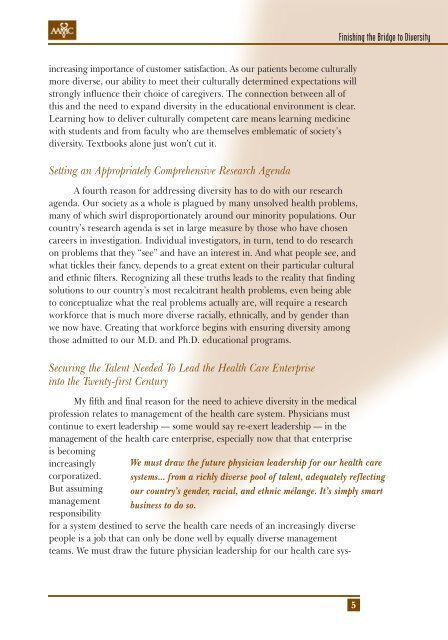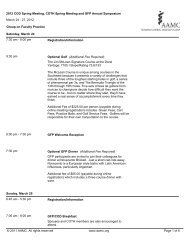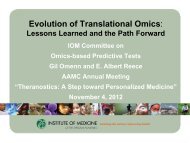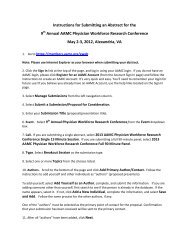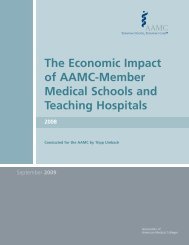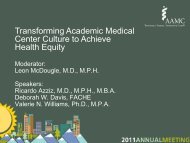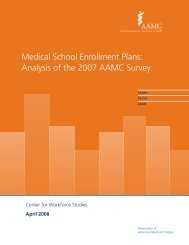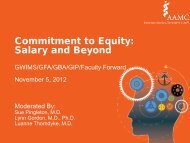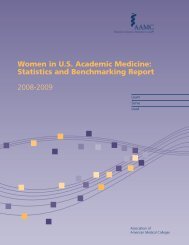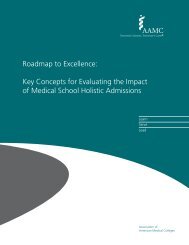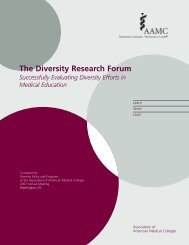Finishing the Bridge to Diversity - Member Profile - AAMC
Finishing the Bridge to Diversity - Member Profile - AAMC
Finishing the Bridge to Diversity - Member Profile - AAMC
You also want an ePaper? Increase the reach of your titles
YUMPU automatically turns print PDFs into web optimized ePapers that Google loves.
<strong>Finishing</strong> <strong>the</strong> <strong>Bridge</strong> <strong>to</strong> <strong>Diversity</strong><br />
increasing importance of cus<strong>to</strong>mer satisfaction. As our patients become culturally<br />
more diverse, our ability <strong>to</strong> meet <strong>the</strong>ir culturally determined expectations will<br />
strongly influence <strong>the</strong>ir choice of caregivers. The connection between all of<br />
this and <strong>the</strong> need <strong>to</strong> expand diversity in <strong>the</strong> educational environment is clear.<br />
Learning how <strong>to</strong> deliver culturally competent care means learning medicine<br />
with students and from faculty who are <strong>the</strong>mselves emblematic of society’s<br />
diversity. Textbooks alone just won’t cut it.<br />
Setting an Appropriately Comprehensive Research Agenda<br />
A fourth reason for addressing diversity has <strong>to</strong> do with our research<br />
agenda. Our society as a whole is plagued by many unsolved health problems,<br />
many of which swirl disproportionately around our minority populations. Our<br />
country’s research agenda is set in large measure by those who have chosen<br />
careers in investigation. Individual investiga<strong>to</strong>rs, in turn, tend <strong>to</strong> do research<br />
on problems that <strong>the</strong>y “see” and have an interest in. And what people see, and<br />
what tickles <strong>the</strong>ir fancy, depends <strong>to</strong> a great extent on <strong>the</strong>ir particular cultural<br />
and ethnic filters. Recognizing all <strong>the</strong>se truths leads <strong>to</strong> <strong>the</strong> reality that finding<br />
solutions <strong>to</strong> our country’s most recalcitrant health problems, even being able<br />
<strong>to</strong> conceptualize what <strong>the</strong> real problems actually are, will require a research<br />
workforce that is much more diverse racially, ethnically, and by gender than<br />
we now have. Creating that workforce begins with ensuring diversity among<br />
those admitted <strong>to</strong> our M.D. and Ph.D. educational programs.<br />
Securing <strong>the</strong> Talent Needed To Lead <strong>the</strong> Health Care Enterprise<br />
in<strong>to</strong> <strong>the</strong> Twenty-first Century<br />
My fifth and final reason for <strong>the</strong> need <strong>to</strong> achieve diversity in <strong>the</strong> medical<br />
profession relates <strong>to</strong> management of <strong>the</strong> health care system. Physicians must<br />
continue <strong>to</strong> exert leadership — some would say re-exert leadership — in <strong>the</strong><br />
management of <strong>the</strong> health care enterprise, especially now that that enterprise<br />
is becoming<br />
increasingly We must draw <strong>the</strong> future physician leadership for our health care<br />
corporatized. systems... from a richly diverse pool of talent, adequately reflecting<br />
But assuming our country’s gender, racial, and ethnic mélange. It’s simply smart<br />
management<br />
business <strong>to</strong> do so.<br />
responsibility<br />
for a system destined <strong>to</strong> serve <strong>the</strong> health care needs of an increasingly diverse<br />
people is a job that can only be done well by equally diverse management<br />
teams. We must draw <strong>the</strong> future physician leadership for our health care sys-<br />
5


